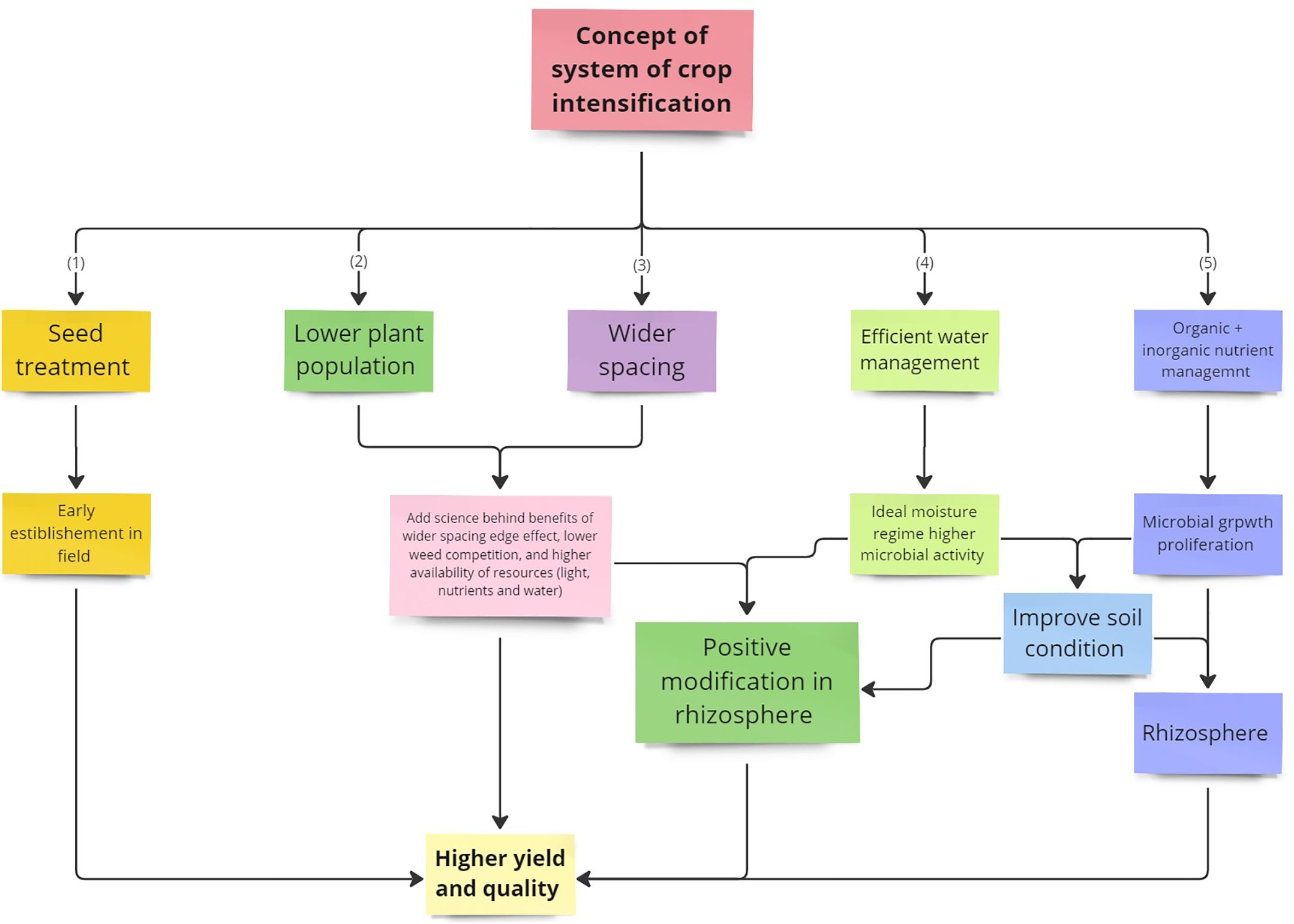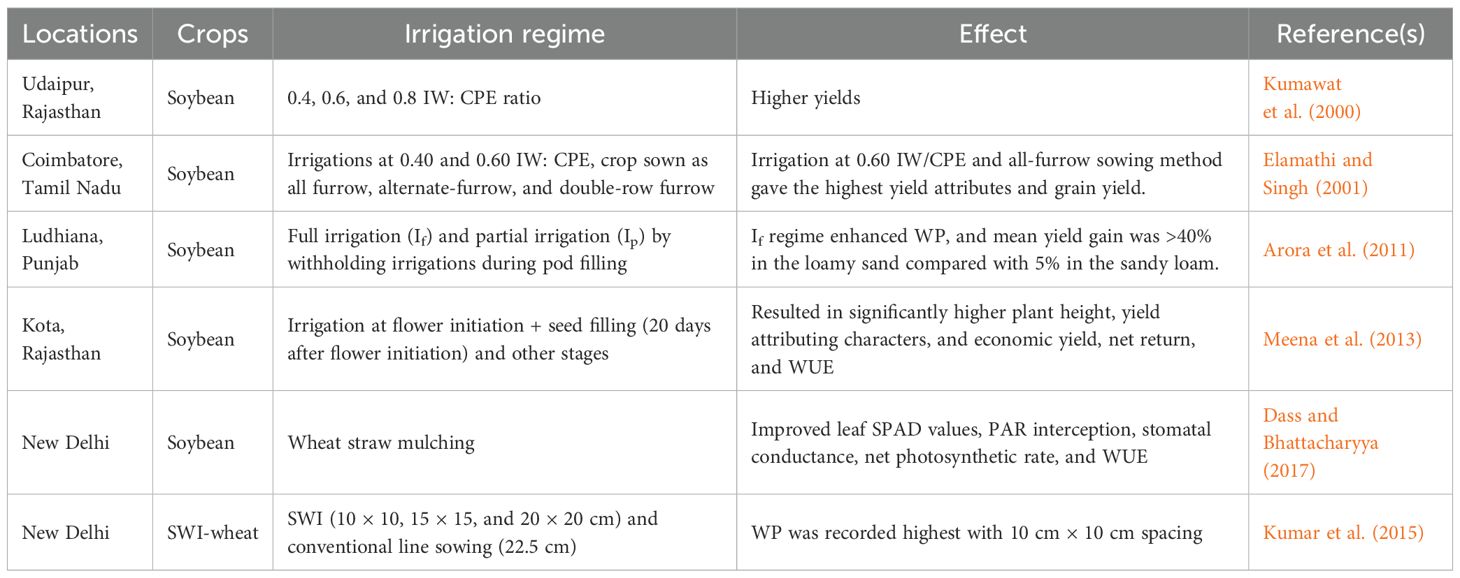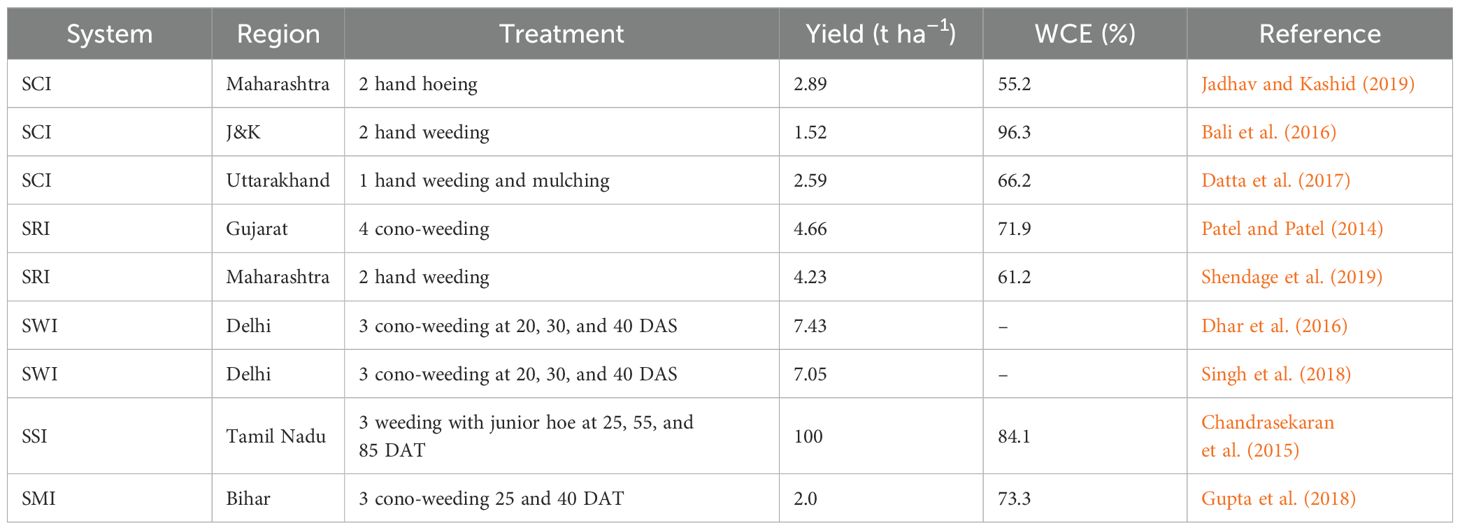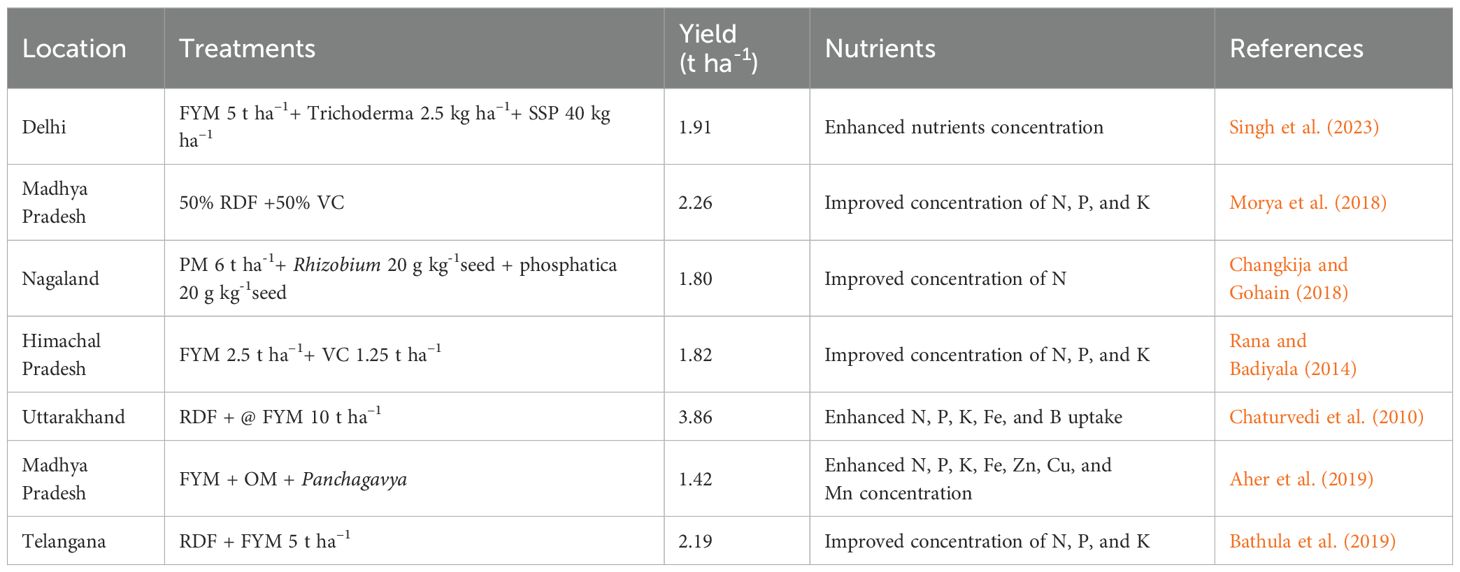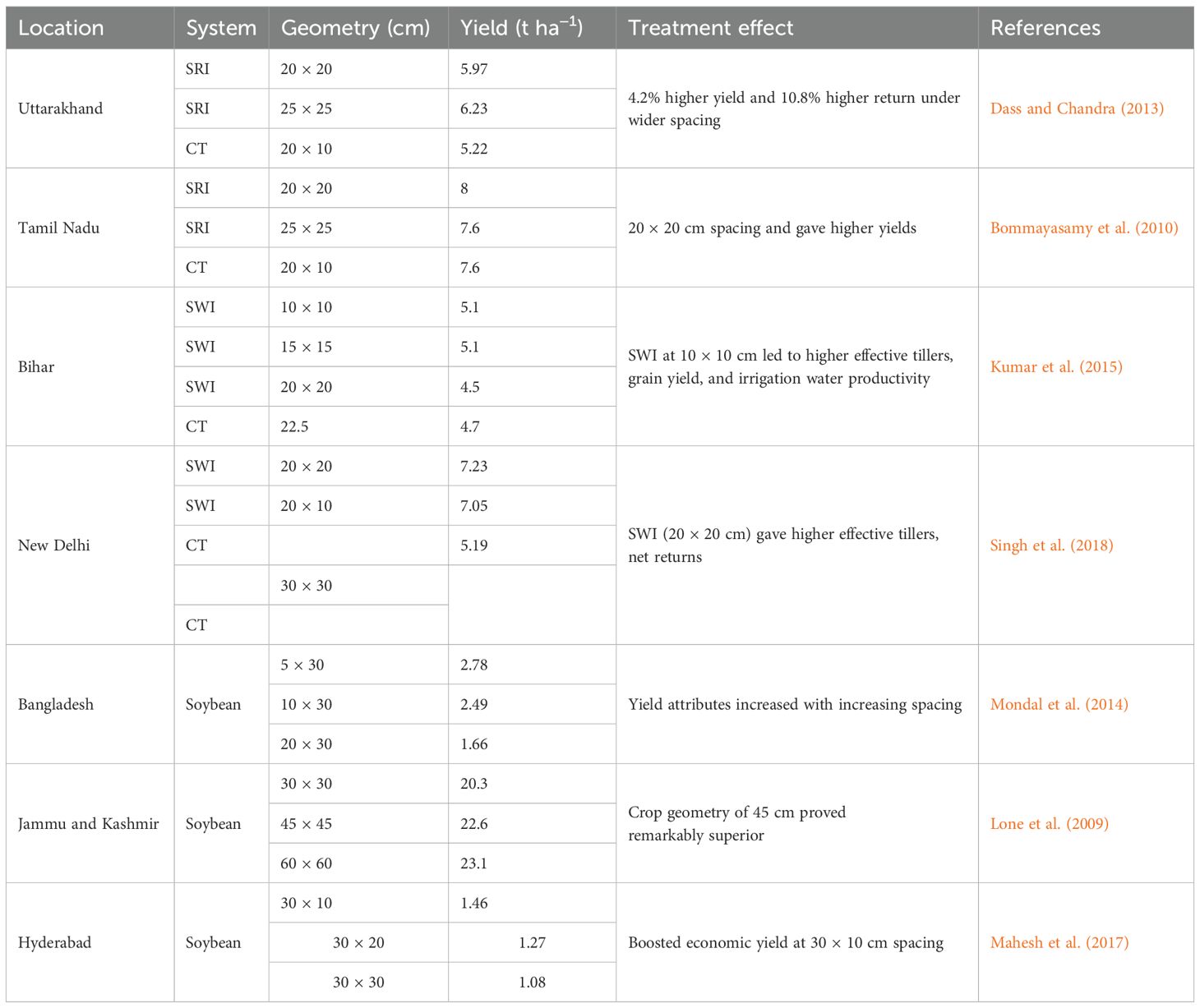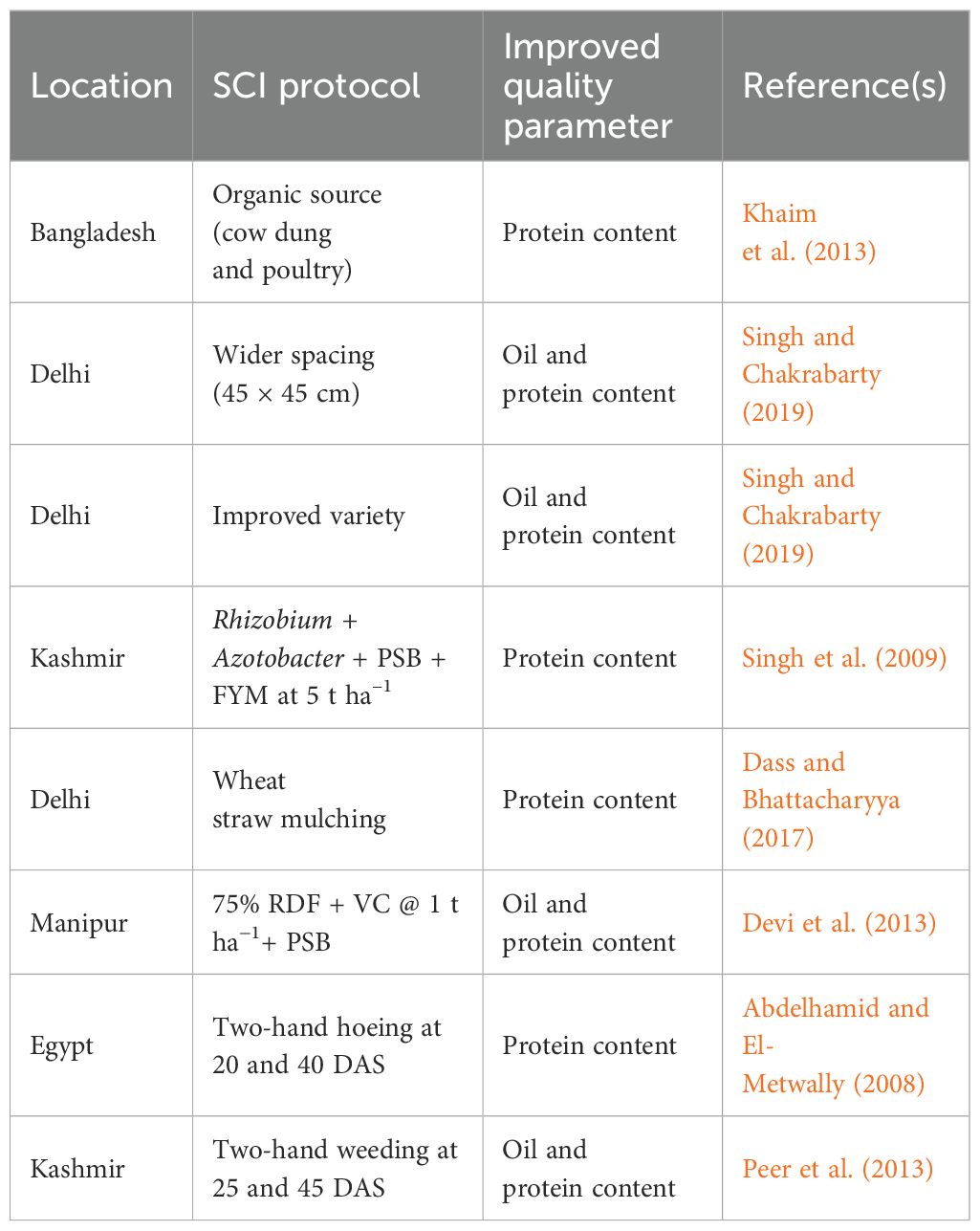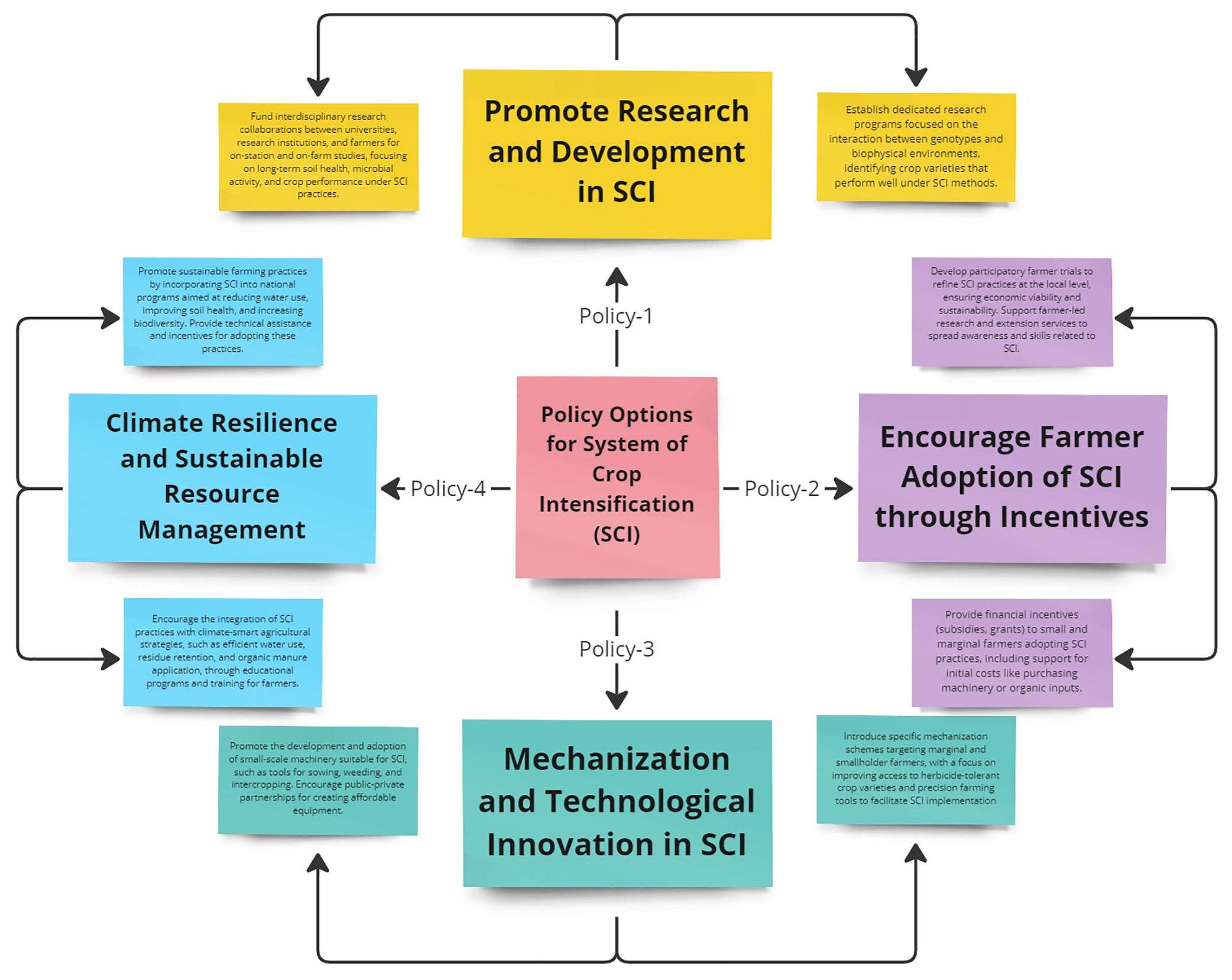- 1ICAR-Indian Agricultural Research Institute, New Delhi, India
- 2Research Centre, ICAR-Indian Institute of Soil and Water Conservation, Vasad, Anand, Gujarat, India
- 3ICAR-Central Rice Research Institute, Cuttack, Odisha, India
- 4ICAR-Central Coastal Agricultural Research Institute, Old Goa, Goa, India
- 5ICAR- Indian Grassland and Fodder Research Institute, Jhansi, Uttar Pradesh, India
- 6ICAR-Directorate of Groundnut Research, Regional Research Station, Ananthapur, Andhra Pradesh, India
- 7ICAR-Indian Agricultural Research Institute, Regional Station, Samastipur, Bihar, India
- 8Vasantrao Naik Marathwada Krishi Vidyapeeth, Parbhani, Maharashtra, India
- 9Dr. Rajendra Prasad Central Agricultural University, Pusa Samastipur, Bihar, India
Context: Meeting the rising global nutritional demands is a critical challenge due to population growth, increasing incomes, shrinking natural resources, and climate change. Enhancing crop productivity while ensuring sustainability requires innovative and efficient agricultural practices. The System of Crop Intensification (SCI), adapted from the System of Rice Intensification (SRI), offers a promising solution by optimizing agronomic management for various crops, such as wheat, millets, maize, sugarcane, rice, and soybean.
Research question: This review examines the potential of SCI in improving crop yields, profitability, and resource use efficiency. The primary research question is: How does SCI impact crop productivity, soil health, and farmers’ income compared with conventional farming methods?
Methods: The review synthesizes recent studies and field trials on SCI adoption across multiple crops and regions. Key agronomic modifications considered include wider planting geometry, improved water management, organic manure application, residue retention, and integrated weed management. The effects of SCI on yield, nutrient uptake, soil quality, resource-use efficiency and economic returns were analyzed.
Results: SCI practices have demonstrated a significant yield increase, often more than doubling production compared with conventional methods. The adoption of SCI has resulted in a 15%–25% yield improvement in major field crops, along with enhanced oil and protein content, increased nutrient uptake, and improved water-use efficiency. Although SCI involves higher initial production costs, the increased crop yields compensate for the expenses, leading to higher net returns for farmers.
Conclusions: SCI is an effective and sustainable agronomic approach that enhances productivity while improving soil health and resource-use efficiency. The approach contributes to climate resilience and profitability, making it a viable option for small and marginal farmers. The observed improvements in soil–plant interactions indicate the need for further scientific exploration of the mechanisms driving these benefits.
Implications: SCI provides an ecologically sustainable solution to global food security challenges. Its adoption at a wider scale can significantly increase farmer incomes, enhance soil fertility, and contribute to environmentally friendly farming practices. Encouraging research, demonstration, and policy support for SCI will be crucial in ensuring its widespread implementation and long-term success.
1 Introduction
Global food security requires agricultural sectors to adopt sustainable intensification practices (Royal Society, 2009; Panel, 2013). Farmers with ample land, technology, and resources boost productivity by cultivating larger areas, relying on improved crop varieties, fossil fuels, water, and agrochemicals, increasing outputs through intensive inputs (Korav et al., 2024; Adhikari et al., 2018; Gopinath et al., 2022), but there have been increased economic and environmental consequences on farmers and ecosystems (Peng et al., 2010; Harish et al., 2022). Moreover, when external inputs predominate in intensification, agro-ecology provides alternatives for improving natural resources, such as species and genetic diversity (Jat et al., 2025). Therefore, managing land and water resources is essential to sustaining the agriculture production system and feed expanding human populations as these resources become scarcer (Jinger et al., 2025).
At the moment, SCI has emerged in several countries, enabling stakeholders to employ less labor, water, seed, and other financial resources while still increasing the productivity of their land (Abraham et al., 2014). According to Adhikari et al. (2018), the ideas and methods that led to SCI were impacted by the experiences that farmers and researchers had with the SRI. As a result of the SCI’s success in restoring the productivity of various crops, including cereals, pulses, oilseeds, and millets, new crop cultivation techniques like the SWI (system of wheat intensification) and SSI (system of soybean intensification) have been developed (Dhar et al., 2016; Rana et al., 2017; Singh et al., 2023, 2024). The available resources are used at their best within the farm under SCI by reduced dependency on external resources. The results of experiments conducted in different regions of the world revealed that SCI practices helped to not only improve productivity but also sustain the agroecosystem through interlinking various biological processes and management options for enhanced system yields (Uphoff et al., 2006; Behera et al., 2013; Uphoff et al., 2013). Small and marginal farmers are getting higher yields at reduced cost of cultivation, employing SCI methods (Thakur et al., 2010), and also, this system shows greater resilience to climate change (Zhao et al., 2009; AKRSP-I, 2013). Farmers are getting an additional yield of 1.75 t ha−1in finger millet by practicing SCI through best agro-management (Uphoff et al., 2011; Thavaprakaash, 2017).
2 Brief history of system of crop intensification
Significant efforts have been made on improved and modern agricultural inputs like stress-tolerant (both biotic and abiotic) high-yielding cultivars, irrigation water, inorganic fertilizers, and pesticides to increase food-grain production. This strategy, during the pre-and post “green revolution” era, despite raising the food-grain production resulted in diminishing agronomic and economic returns including environmental degradation. These high input practices have caused unfavorable results on soil health, groundwater quality, and biodiversity (Peng et al., 2010; Pingali et al., 1997). Considering the current changing climate scenario, development of some potential alternatives for agricultural sustainability with appropriate agroecological principles through SCI is the need of the hour.
The concepts and practices of SCI have been derived from farmers’ experience of “SRI” developed in 1983 by “Father Henri de Laulanie” in Madagascar (Toungos, 2018). Initially, as the method succeeded with rice, it was assumed that it would apply only for monocotyledons (Adhikari et al., 2018).
System of crop intensification principles can be applied to a number of crops and can be designated specifically for rice (SRI), mustard (SMI), wheat (SWI), millet (SMtI), sugarcane (SSI), and so on depending on the crop applied with SCI methods (Uphoff, 2024; Kumar et al., 2024; Ujjwal et al., 2022; Muchhadiya et al., 2021; Biswas and Das, 2023; Cardozo et al., 2018). SCI satisfies the conception and aim of “sustainable intensification” and effects of SCI are indeed attainable with the appropriate use of agroecological principles and practices, which originate from plants with larger, more effective, and longer-lasting root systems and their symbiotic connections with a profusion of vibrant, active, and varied soil micro-biota (Adhikari et al., 2018).
3 Principles and practices of SCI
System of crop intensification have been derived from the characteristics/attributes responsible for achieving productive potentials of the crops (Figure 1). The production potential of crops depends mainly upon the broader-lived root systems of the plants, which are more efficient in nutrient and water uptake having strong symbiotic relationships with rhizosphere active soil biota (Verma, 2013; Yanni et al., 2001). Roots always encourage and sustain the diversity of soil microorganisms by releasing root exudates which favorably modify chemical and physical properties of soil that, in turn, supply nutrients and provide protection to the root system (Figure 1).

Figure 1. Principles and practices of SCI (Ref: Dinesh et al., 2019).
System of crop intensification can include direct seeding in addition to the other techniques, decreasing labor requirement, and can be more successful with crops like wheat. Agroecological management, whether for SRI or SCI, requires meticulous crop establishment. High-quality seeds at early, vigorous growth and a better root system that allows for optimal wide spacing between plants to minimize antagonism for inputs, sunlight, and water are key components of SCI, as they allow each plant to reach its full genetic potential while reducing competition from weeds (Figure 2). The impact of adapting SCI in different crops has been discussed in the following sections.
4 Management options under system of crop intensification
4.1 Water management in SCI
One of the important principles of SCI is better water management for higher efficiency (Thiyagarajan et al., 2002; Ceesay et al., 2006). Although under saturated soil conditions, there was a small yield reduction (only 6%) reported with alternate wetting and drying, water saving was 23% of conventional methods of irrigation (Bouman and Tuong, 2001). Among other crops, furrow irrigated bed planting of wheat saved 40% more water and increased productivity significantly (Kumar et al., 2010, 2015; Uphoff, 2012).
At SSI, it is generally recommended to manage crop water management requirement immediately after sowing. Moreover, life-saving irrigation should be given on the 3rd day of germination and subsequent irrigation should be provided at an interval of 7–10 days in summer and 10–15 days in winter seasons. The water requirement of soybean depends upon crop cultivar, duration, growing season, and irrigation method (Rajendran and Lourduraj, 2000).
Narrow row spacing and variable N application rates regulate the soil micro-climatic conditions and WUE (Dass and Bhattacharyya, 2017; Moreira et al., 2015) (Table 1). The yield, oil content, and protein content of soybean were significantly higher at precision water management (Haqmal et al., 2023; Kumawat et al., 2000; Elamathi and Singh, 2001; Meena et al., 2013).
4.2 Weed management
Weeds are the most underrated crop pest causing a huge loss to crop production (60%–65%) through competition for nutrients, space, moisture, and light (Jinger et al., 2017; Gaikwad and Pawar, 2002; Vyas and Chandel, 2019). However, the weed scenario and management aspect are entirely different in SCI as compared with the normal cultivation of crops (Singh et al., 2018, 2024). This practice stimulates beneficial soil organisms and at the same time reduces weed competition. Two-hand hoeing accomplished at 20 and 40 DAS and two-hand weeding at 15 and 35 DAS in soybean enhanced soil aeration, microbial activity, and root growth of soybean at SSI (Dass et al., 2015) and SWI (Dhar et al., 2016). In SRI, farmers are efficiently operating cono-weeder, which leads to saving of labor and time (Mrunalini and Ganesh, 2008). Furthermore, integration of cono-weeding along with hand weeding could prove to be a versatile technique for controlling weeds, improving productivity and soil health under SCI without harming the other natural resources (Table 2). No-cost tactics like weed competitive varieties and mulching can also be inculcated for weed management in SCI, since these practices have shown significant results in reducing weed density and enhancing productivity under SRI techniques (Haden et al., 2007; Liebman and Schulte, 2015).
4.3 Nutrient management
Although complete organic manuring is recommended for SCI, in case of low availability, inorganic fertilizers could be applied. Many researchers have reported that SCI protocols significantly improved nutrient availability (Table 3), it was maximum at 30 × 30 cm of soybean (Singh et al., 2023). It is possible that using organic nutrient sources improved soil aeration, facilitated better root proliferation, and increased water and nutrient absorption, and continuously supplied balanced nutrients (Kumar et al., 2015). Similarly, RDF + FYM (Chaturvedi et al., 2010) and RDF + vermicompost (Morya et al., 2018) were found to result in the maximum uptake of NPK in soybean.
5 Effects on crop growth and development
5.1 Effects of planting density on growth parameters
The SRI is based on the ideas of reduced plant density, improved soil conditions, controlled watering, and early, rapid, and healthy plant establishment. SRI needs a very low seed rate of 8–10 kg ha–1, and younger seedlings (8–12 day-old) are transplanted with single plant hill–1(San-oh et al., 2006; Dass et al., 2015). A solitary seedling on each hill promotes root length, density, and their mutual reliance with the development of the above-ground canopy, especially extended photosynthetic activity (Mishra et al., 2006; Dass et al., 2015; Dass et al., 2016; Toungos, 2018).
The SWI utilizes a lesser seed rate of approximately 25–30 kg ha−1, in contrast to the normal sowing method, which requires 100–140 kg ha−1. As per the principles of SCI, seed treatment in SWI is done with 20% salt solution with cow urine, jaggery, and fungicide for better growth and yield (Dhar et al., 2016; Gupta et al., 2018; Raghavendra et al., 2019; Sachin et al., 2023a; Singh et al., 2023). In comparison with untreated seeds, seed treatment is claimed to have a positive impact on greater effective tillers, number of grains, and test weight of wheat in SWI (Bhargava et al., 2016). It has also been discovered that the sowing technique in SWI significantly influences growth and productivity. A yield benefit of 13% was obtained by dividing sowing in SWI, compared with transplanting, which required 30%–40% less labor (Dass et al., 2018; Singh et al., 2018; Gupta et al., 2018; Sachin et al., 2023b; Singh et al., 2024).
In the context of sugarcane intensification, compared with traditional planting techniques, the amount of seed needed was decreased by 75% by raising the nursery with single-budded chips, transplanting early seedlings (25–35 days old), and keeping wider spacing (Gupta et al., 2018; Sachin et al., 2023b). In maize, direct seeding of one to two seeds per hill under SCI showed a yield advantage of 75% over conventional methods (Adhikari et al., 2018; Sesta, 2015). SCI has been used in mustard among oilseed crops; methods include seed priming, raising nurseries with treated or sprouted seeds, transplanting 8–12-day-old seedlings with only three to four leaves.
5.2 Effect of planting geometry and plant density on productivity
Wider plant spacing is a prerequisite to proper root development, healthy plant growth, and enhancing nutrient uptake. Wider spacing is required for improved root–shoot growth and development of individual. Higher yield at SRI is mainly attributed to wider spacing, which results in profuse tillering higher yield (Baloch et al., 2002; Sharma and Masand, 2008). Dass and Chandra (2013) reported that under SRI, 4.2% higher yield, better grain quality, and 10.8% higher income were obtained with wider spacing than closer spacing (Table 1). Increased grain yield and net profit were observed at a 20 × 20 cm spacing (Bommayasamy et al., 2010) (Table 1).
Like SRI, SWI heavily relies on the concept of root development. Because SWI practices create aerobic soil conditions (Rana et al., 2017). Conventional line sowing (22.5 cm) with untreated seeds of wheat was compared with treated seeds in SWI (25 × 25 cm), and it was significantly higher (Bhargava et al., 2016). Chopra and Sen (2013) demonstrated the advantages of wider spacing (20 × 20 cm) in increasing yield attributes (Table 4) and yield of wheat over closer spacing (15 × 15 cm). SWI at 10 × 10 cm led to higher effective tillers, grain yield, and irrigation water productivity (Singh et al., 2018). Singh et al. (2018) assessed three different techniques of cultivating soybeans under the soybean-wheat system: conventional and SCI with two spacings of 45 × 45 cm and 30 × 30 cm; they found that SCI significantly increased the weight of 100 seeds, pods plant−1, and seeds pod−1.
5.3 Effect on grain quality parameters
According to Diep et al. (2016)and Singh et al. (2018), increased N and S contents in grain as a result of enhanced soil N and S through FYM + bio-fertilizers and SSP treatment was responsible for the improvement in oil and protein contents (Table 5) under SCI. Greater root development, increased root activity, delayed leaf senescence, increased chlorophyll concentrations, photosynthetic rates, and effective assimilation transit from source to sink are potential causes of superior grain quality (Satyanarayana et al., 2007). Moreover, the application of 75% RDF combined with 1 t ha−1of vermicompost and PSB resulted in noticeably greater oil and protein contents in the soybean seed (Devi et al., 2013). This might be as a result of the nutrients being more easily soluble in the crop root zone due to the organic acids generated by the decomposing organic waste (Singh et al., 2009; Khaim et al., 2013; Abdelhamid and El-Metwally, 2008).
5.4 Profitability or economic evaluation of SCI
The profitability of any production system depends upon two aspects, i.e., cost of production and level of output (Dhar et al., 2016; Singh et al., 2018). SCI has been reported to incur more cost of production in the form of cost of labor and organic inputs (Pradan, 2012). However, higher productivity per unit of production factors, viz., land, labor, seeds, water, and capital, makes the SCI economically feasible and profitable (Dash and Pal, 2011; Araya et al., 2013; Singh et al., 2018). Moreover, once the SCI practice gets established and acquainted by farmers, the costs of production reduce significantly and higher yields further make the SCI more profitable (Singh et al., 2018). The possible factors of improved productivity and profitability in SCI-based soybean crop production are reduced seed rate, optimized sowing time, precise water application, and effective weed management. SFMI was extremely profitable since, although farmers’ costs increased by roughly 25% as a result of the intensive management, their production cost was offset by 60% by the greater yields (Dhar et al., 2016; Behera et al., 2013). Because of the struggle for resources, high plant density results in poorer production and an increase in seed rate, which reduces benefits.
6 Effects on soil properties
6.1 Physical properties
Soil physical property is used as an essential phenomenon in aspects of soil physical process (Abdulkareem et al., 2020). These are the processes that have an impact on the soil’s physical strength as well as its capacity to hold and move water and air in a way that promotes plant growth. Because it influences the soil’s chemical and biological activities, soil physical quality is crucial to the overall quality of the soil (Dexter, 2004). The use of organic soil amendment is the main element in SCI to enhance its fertility, maintain structure, and also support the soil biota. Soil moisture holding capacity is enhanced by organic matter, thus continuously providing moisture to the root zone and reducing the need for continuous irrigation (Adhikari et al., 2018). More pore space is produced in SCI by elevated quantities of organic matter and related soil fauna. The chemical and physical characteristics of the soil, as well as its general health, are influenced by organic matter (Table 6). Organic matter affects the following properties: soil structure; soil organism diversity and activity; soil moisture holding capacity; and soil nutrient availability (Gupta et al., 2018; Singh et al., 2023; Pogula and Rout, 2018).

Table 6. Soil quality values of SRI and conventional practice after harvesting using Dexter’s soil quality equation (Abdulkareem et al., 2020).
6.2 Soil microbial and faunal communities
Earlier, SCI was described as a system of root intensification (Verma, 2013). However, later research revealed that beneficial soil organisms also play a crucial role since they interact with the root systems in a synergistic way, contributing to crop productivity simultaneously (Yanni et al., 2001). By their chemical and physical effects on the soil, roots aid in the growth and diversity of soil organisms, which in turn provide the plant itself with protection and access to nutrients. In accordance with SCI principles, weeds should be removed to enable the soil system to better absorb and circulate water, nutrient, and air. Additionally, beneficial soil organisms, such as earthworms, should be encouraged, as this will lessen weed competition. It has been reported that a substantial portion of ingested seeds are digested or lose their vitality after passing through the earthworm gut (Aira and Piearce, 2009; Laossi et al., 2009; Clause et al., 2015). Seed translocation by earthworms is considered to be an important factor affecting the vertical distribution of weed seeds in soil (Laossi et al., 2010). Reliance on inorganic agrochemicals is reduced and negative impacts on beneficial soil organisms are avoided, all of which are essential for the success of SCI (Adhikari et al., 2018; Sachin et al., 2023a; Singh et al., 2024). Uphoff et al. (2013) and Anas et al. (2011) have reported a more than 50% increase in SRI aerobic bacteria before and during panicle initiation, which improves these interactions. In contrast, phosphate-solubilizing bacteria rose by about 75%. The population of Azospirillum, Azotobacter, and another diazotroph (N-fixing) bacterium also increased.
6.3 Soil organic matter and nutrient availability
By adding organic matter (OM) amendments, SCI enhances the soil’s characteristics and helps to stabilize soil aggregates and pores by utilizing OM’s adhesion and bonding qualities. Important chemical indicators of soils like pH, CEC, and nutrient availability are altered by the presence of OM, primarily in the form of P content (Martínez et al., 2013). Furthermore, transitory and stable components (humic compounds) have been found to significantly enhance nutrient availability and acquisition by higher plants. The primary source of N and S as well as P in many soils is OM. It is the repository for micronutrients like iron and copper and controls the plants’ access to these nutrients (Gerke, 2022). Therefore, before tilling the ground, apply FYM or composts. Inorganic fertilizers could be added to the scarcity of organic fertilizers, nevertheless, if soil test results at the time of field preparation indicate that this will improve yields (Jat et al., 2023). According to Yang et al. (2004), it increases the friability of the soil, which promotes increased root growth. Larger, more varied, and more active populations are supported by greater organic matter (OM) in the soil (Anas et al., 2011; Yang et al., 2004). While comparing chemical fertilizers, chemical fertilizers with FYM, and chemical fertilizers with wheat straw under continuously flooded irrigation and alternate submergence, it has been reported that the number of panicles ha−1, full grains panicle–1, and 1,000-grain weight of rice were all reduced by 21%, 19%, and 8.3%, respectively, under application of only chemical fertilizers. This led to an 18% loss in grain yield (Table 7).

Table 7. Grain yield and its components (Yang et al., 2004).
6.4 GHG emission
Global warming and climate change are two hot issues that have become a public concern and considerable topic of debate for the scientific community. One of the main greenhouse gases is methane (CH4), and one of the main sources of soil-emission CH4 emissions is thought to be from rice fields that are submerged in water. During the anaerobic microbial breakdown of organic matter, methane is generated in the soil. Less oxygen and other gases, such sulfates, were present in the soil due to flooding in the fields. Increased methane emissions into the atmosphere are a result of this condition encouraging methanogenesis (Bouwman, 1990). According to Cicerone et al. (1992); Neue et al. (1990), and Paramesh et al. (2023), a traditional paddy field that is continuously flooded is a significant producer of CH4. Paddy fields also release other gases, such as nitrous oxide (N2O) and carbon dioxide (CO2). Rice farmers can fight against climate change by using an alternate irrigation system over continuous flooding, which results in reduction of emission of greenhouse gases from the rice field (Tyagi et al., 2010). This is one of the strategies of SRI. On the other hand, when soil conditions change to the aerobic state, aerobic bacteria produce more N2O, which has a 12-fold greater potential for global warming. This assessment took into account far minor modifications made with SRI to normally irrigated rice farming, following the guidelines set forth by the Intergovernmental Panel on Climate Change (IPCC). Based on Mboyerwa (2018) and Hidayah et al. (2009), it seems that SRI could, in fact, contribute positively to reducing greenhouse gas emissions (Table 8).
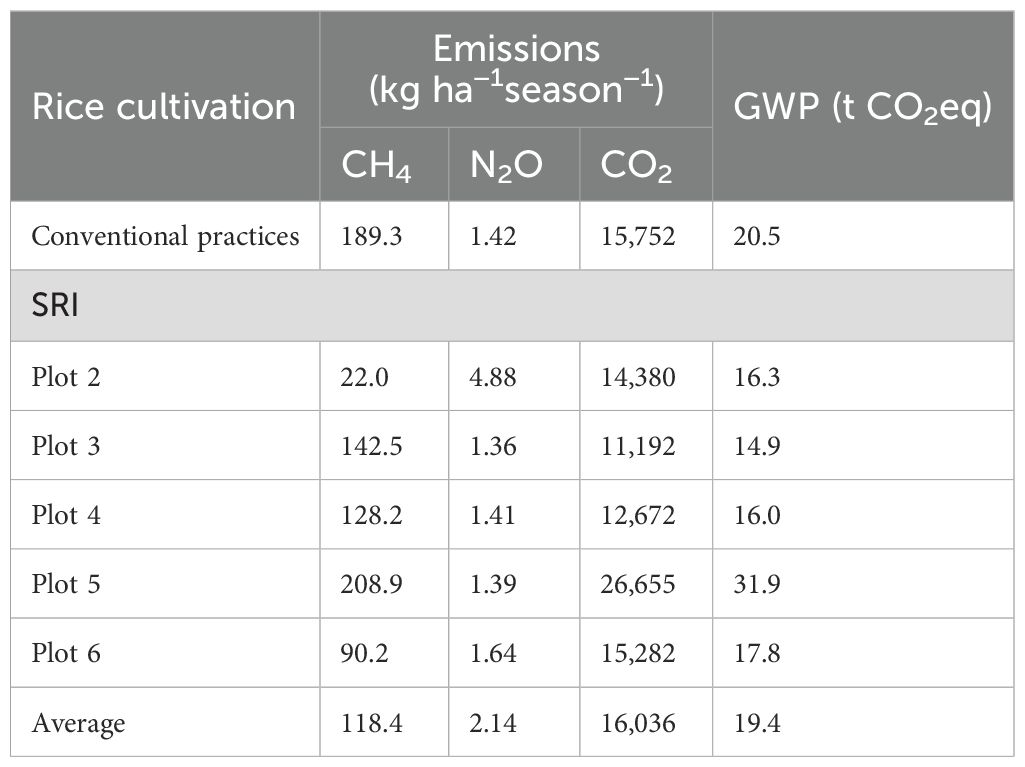
Table 8. GHG emission from conventional and SRI paddy fields (Hidayah et al., 2009).
7 Resource-use efficiency
7.1 Nutrient-use efficiency
The SCI seeks to optimize the benefits that can be derived from these resources. A wider spacing with a lower N rate led to greater N uptake under SRI than narrow spacing in conventional rice cultivation at a higher N rate. Thus, plant spacing increases NUE under SRI (Singh and Chakrabarty, 2019). In SRI, the incorporation of OM into the soil can bring a positive effect to root growth under intermittent irrigation. It leads to increase in root density, root oxidation ability, higher nutrient uptake (Table 9) by active absorption area and hence higher NUE (Yang et al., 2004; Toungos, 2018).
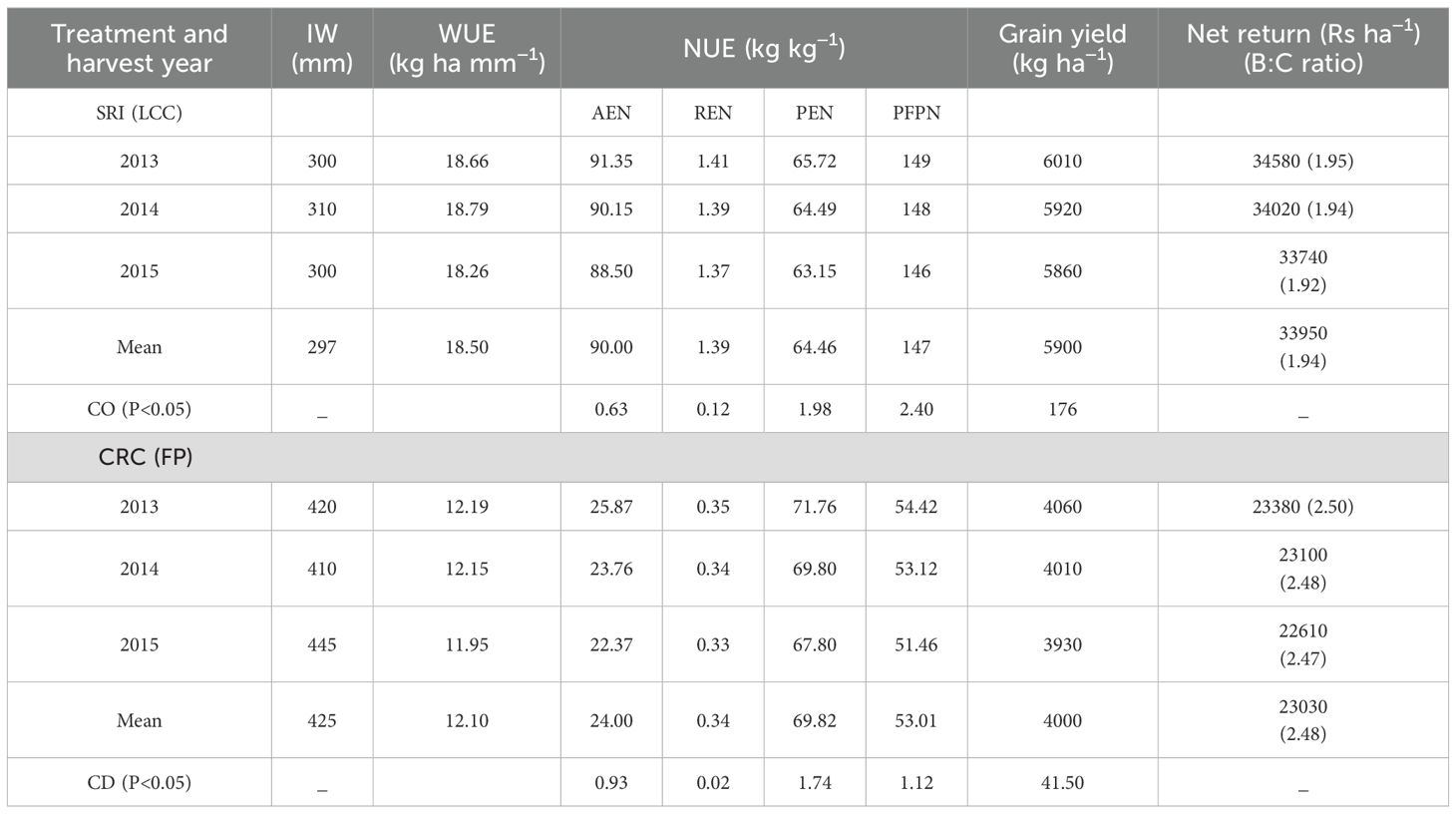
Table 9. Impact of management practices on use efficiency (water, nitrogen) and net return (Singh et al., 2018).
7.2 Water productivity
As a green invention, the SRI uses less water, which means that there is less competition for water between the needs of natural ecosystems and the production of food. In addition, SRI assessment and distribution are carried out by the Worldwide Fund for Nature (WWF). SRI techniques significantly lower water consumption when compared with conventional techniques (Thakur et al., 2010; Narayanamoorthy and Jothi, 2019). Additionally, farmers that used the SRI approach in groundwater irrigation settings as opposed to tank and canal irrigation saw comparatively better levels of paddy output and water savings (Table 10). In order to boost water and economic production, the SRI approach may be a good choice.
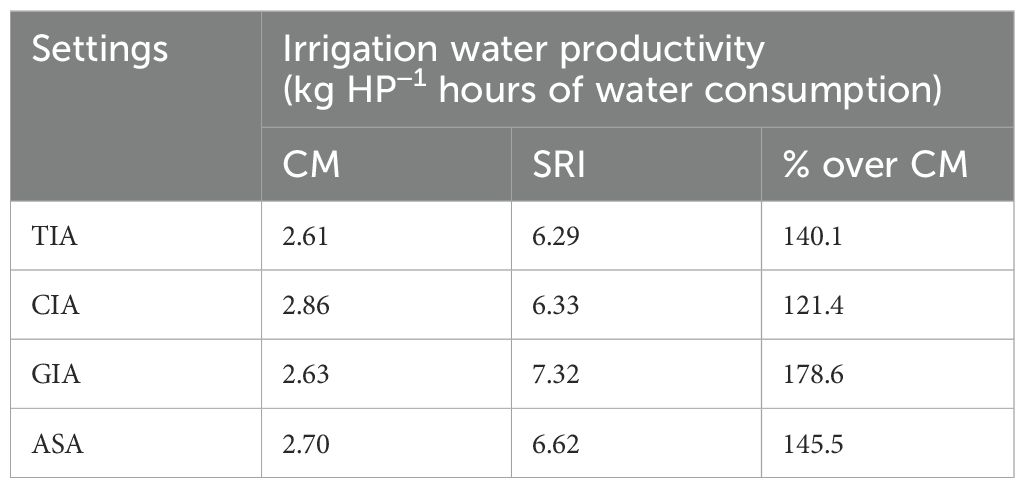
Table 10. Water productivity of SRI and non-SRI paddy (Narayanamoorthy and Jothi, 2019).
7.3 Radiation-use efficiency
The radiation use efficiency (RUE) was calculated to account for biomass buildup and radiation that is intercepted by the canopy for photosynthetic activity, and it was assessed in non-plant growth-limiting circumstances (Hatfield, 2014). The primary organ of photosynthesis in plants is the leaf surface; the growth rate per unit leaf area, or net assimilation rate, can sometimes be expressed in this way. Since most of the leaves are exposed to direct sunlight when the plants are tiny, it is high (Swarna et al., 2017). Thakur et al. (2010) and Kumar et al. (2019) reported that modified SRI led to higher light interception than conventional planting. Plant spaced at 20 × 20 cm showed the maximum light interception values, whereas a lower value was recorded with plant spacing at 25 × 25 cm.
8 Climate resilience
As per the report of Watershed Organization Trust (WOTR), the SCI method enhances the plant’s resilience and adaptive ability (WOTR, 2021). The plants in the SRI system develop healthier with a stronger root system (Singh et al., 2014) and are able to endure high-intensity rainfall, strong winds, high heat, and dry spells with much less damage (Figure 3; NABARD, 2016). Phytochemicals in the plant’s system also help the plant adapt to different climate-induced abiotic as well as biotic stresses (Abraham et al., 2014; Gupta et al., 2018).
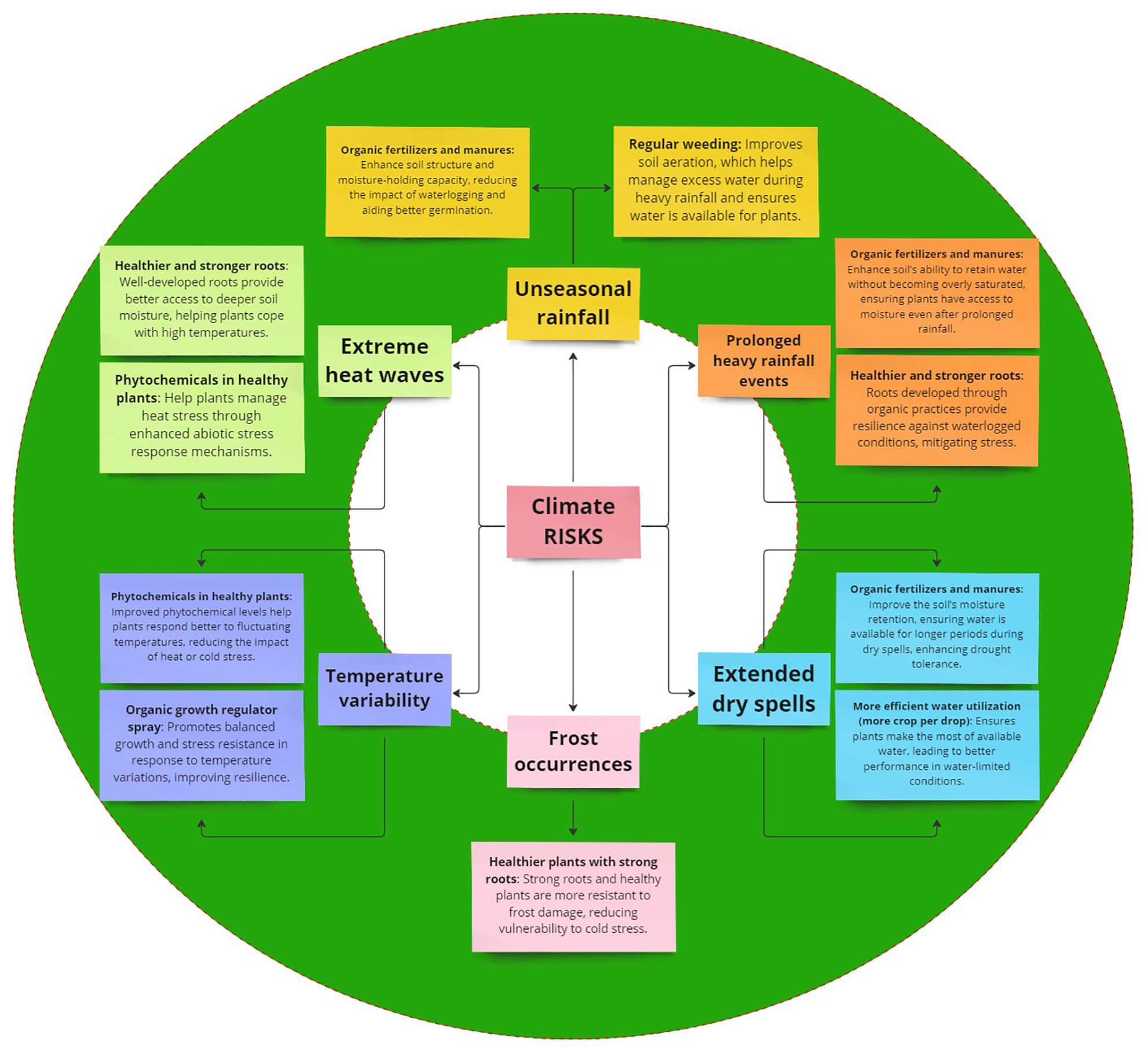
Figure 3. Climate risks, challenges, and solutions (Ref: NABARD, 2016).
9 Challenges and constraints
SCI prerequisites include healthy soil and assured and controlled input supply that could boost crop growth and yield with improved resource use efficiency. This practice is possible with appropriate agricultural mechanization for scaling up basic principles of SCI (Adhikari et al., 2018). Apart from the mechanization, larger and better-functioning root rhizosphere which can buffer the effects of various biotic and abiotic stresses, such as drought, storm, thermal injury, diseases, and pests, is the challenging condition to maintain (NABARD, 2016). Since the concept of SCI is relatively new and not more than two decades old, the availability of appropriate research findings from the specific agroecosystem is therefore a constraint for adopting the justified and evidence-based SCI practice. The modern-day system of intensive crop production with high yield from high-yielding varieties is being realized by putting the high rate of chemical inputs such as fertilizers and pesticides along with overirrigation, which is creating constraints for the adoption of SCI practices because this faulty system is making the agroecosystem fragile where soils are becoming multi-nutrient deficient, are poor in biological activity, have a compact rhizosphere, and have poor plant–microbe symbiosis. All these conditions are identified as a prerequisite for the adoption of SCI practices (Dinesh et al., 2019). Proper crop geometry, healthy seedlings, organic inputs, controlled irrigation, and integrated weed management are the components of the SCI which require skilled manpower, which may be a constraint toward its adoption and promotion (Singh et al., 2018). Different varieties of a crop respond to inputs to varying levels. Some varieties respond well to high fertilizer and irrigation input, which may be less suitable for SCI. Therefore, the identification of a suitable variety that can perform better under the SCI package of practices is another challenge to tackle (Singh et al., 2018). SCI is an integrated approach that integrates various factors of production and functions for creating the most conducive aboveground and belowground micro-climate; hence, Yami and Van Asten (2017)suggest that in order to achieve beneficial outcomes on food security and livelihoods, the design of SCI interventions should adopt holistic methods and take food access into consideration. Other than issues related to production, there are other obstacles to overcome for the widespread adoption and promotion of SCI practices in soybean (Chikowo et al., 2015; Kassie et al., 2015). These include the advancement and diffusion of technologies as well as better agricultural extension and advisory services.
10 Future thrust areas for research on SCI
10.1 Varietal response to SCI and designing suitable plant type
Most of the modern varieties used in SCI cultivation are weak competitor ideotypes that under-perform in a highly competitive crop community, whereas in SCI, crop geometry is altered whereby sufficient space is provided for each plant. SCI researchers should look for the identification of strong competitive plant types that will perform better individually when provided with sufficient space and resources.
10.2 Identification of niche areas/zones most suited for SCI methods
India’s soybean experts began exploring other options, such as intercropping, relay cropping, rotation, and using fallow areas where oilseeds (soybeans, mustard, and peanuts), and pulses may be grown under sustainable crop improvement. A significant gap was identified in Madhya Pradesh, where a sizable portion was formerly left fallow during the rainy season in order to preserve fertility and moisture. Future research on SCI should prioritize the identification of niche agroecological and micro-climatic zones most suited for its application by integrating geospatial analysis with long-term climatic and soil data. This effort must be closely linked with evaluating the suitability of different crops and varieties under diverse conditions to develop location-specific recommendations. Such assessments should consider varying management regimes—such as organic vs. conventional farming, rainfed vs. irrigated systems, and monocropping vs. intercropping—to ensure compatibility and optimize resource use efficiency. Long-term, multi-location trials will be essential to understanding crop responses and refining SCI practices for major crops like rice, wheat, maize, and pulses, thereby enhancing productivity, sustainability, and resilience across regions.
10.3 Detailed studies on soil health and microbial activity
Studies should be conducted to know the long-term impact of management practices on soil health and microbial activities, which will help in improving native soil fertility through the mobilization of various nutrients mediated by microbes.
10.4 Farmer’s participatory trials to fine-tune the technology in terms of its economic viability and sustainability
SCI crop management practices should be designed in such a way that they should be locally acceptable to farmers of that specific region and these should be cost-effective so that even marginal farmers can follow.
11 Policy options
To enhance the adoption of SCI (system of crop intensification), policies should prioritize (Figure 4) (i) research and development—focusing on genotype–environment interactions and sustainable crop varieties and (ii) farmer adoption incentives—through subsidies and participatory trials can help smallholders access SCI technologies and ensure local adaptability. Promoting (iii) mechanization and technological innovation will enhance efficiency, especially with affordable tools for small-scale farmers. Finally, through policies integrating SCI into (iv) climate resilience and resource management, strategies will encourage sustainable practices like efficient water use and improved soil health, contributing to long-term agricultural sustainability and food security.
12 Conclusions
The system of crop intensification (SCI) offers a promising solution to challenges (i.e., climate change, resource scarcity, and soil degradation). It enhances productivity, profitability, and sustainability by optimizing practices such as WUE and NUE. The following conclusions are drawn based on a comprehensive review, as in the following.
1. SCI increases crop yields by 15%–25%, doubling farmer income while improving oil and protein content, nutrient uptake, and water-use efficiency.
2. Soil quality under SCI surpasses conventional methods, enhancing sustainability and climate resilience in cropping systems.
3. SCI reduces GHG emissions and weed challenges, making it an ecologically friendly and profitable farming approach.
4. Despite higher production costs, SCI ensures better net returns through improved resource use and productivity in crops like rice, maize, and soybean.
Overall, widespread adoption of SCI requires collaborative efforts through research, demonstration, and policy support. Scaling up these practices can ensure sustainable farming, improved livelihoods, and a resilient agri-food system.
Author contributions
AD: Writing – original draft, Writing – review & editing. A-AS: Writing – original draft, Data curation. DJ: Writing – original draft, Conceptualization, Writing – review & editing. KK: Formal Analysis, Writing – original draft, Writing – review & editing. AS: Formal Analysis, Writing – original draft. TS: Data curation, Writing – original draft. AP: Writing – original draft. VP: Writing – original draft, Writing – review & editing. GG: Writing – original draft. RG: Writing – original draft. RK: Writing – original draft. KS: Writing – original draft. SR: Writing – original draft. VM: Writing – review & editing. SK: Writing – original draft. AD: Writing – original draft. KN: Writing – original draft. MG: Writing – original draft. HK: Writing – original draft. IM: Writing – review & editing. SM: Writing – original draft.
Funding
The author(s) declare that no financial support was received for the research, and/or publication of this article.
Acknowledgments
We thank the Indian Council of Agricultural Research, New Delhi, for providing the necessary facilities.
Conflict of interest
The authors declare that the research was conducted in the absence of any commercial or financial relationships that could be construed as a potential conflict of interest.
The author(s) declared that they were an editorial board member of Frontiers, at the time of submission. This had no impact on the peer review process and the final decision.
Generative AI statement
The author(s) declare that no Generative AI was used in the creation of this manuscript.
Any alternative text (alt text) provided alongside figures in this article has been generated by Frontiers with the support of artificial intelligence and reasonable efforts have been made to ensure accuracy, including review by the authors wherever possible. If you identify any issues, please contact us.
Publisher’s note
All claims expressed in this article are solely those of the authors and do not necessarily represent those of their affiliated organizations, or those of the publisher, the editors and the reviewers. Any product that may be evaluated in this article, or claim that may be made by its manufacturer, is not guaranteed or endorsed by the publisher.
Abbreviations
CEC, cation exchange capacity; CH4, methane; CO2, carbon dioxide; DAS, days after sowing; FYM, farmyard manure; GHG, greenhouse gas; GWP, global warming potential; IPCC, Intergovernmental Panel on Climate Change; K, potassium; N, nitrogen; N2O, nitrous oxide; NUE, nutrient use efficiency; OM, organic matter; P, phosphorus; PSB, phosphorus solubilizing bacteria; RDF, recommended dose of fertilizers; RUE, radiation-use efficiency; SCI, System of Crop Intensification; SMI, system of mustard intensification; SMtI, system of millet intensification; SRI, System of Rice Intensification; SSI, system of soybean intensification; SSCI, system of sugarcane intensification; SWI, system of wheat intensification; VC, vermicompost; WOTR, Watershed Organization Trust; WUE, water-use efficiency; WWF, Worldwide Fund for Nature.
References
Abdelhamid M. T. and El-Metwally I. M. (2008). Growth, nodulation, and yield of soybean and associated weeds as affected by weed management. Planta Daninha 26, 855–863. doi: 10.1590/S0100-83582008000400017
Abdulkareem J. H., Girei A. H., and Ismail I. A. (2020). Effect of system of rice intensification (SRI) and conventional farmer’s practice on some soil quality indicators in Dutse, Sudan Savannah Zone of Nigeria. Colloquia 44, 341–346.
Abraham B., Araya H., Berhe T., Edwards S., Gujja B., Khadka R. B., et al. (2014). The system of crop intensification: reports from the field on improving agricultural production, food security, and resilience to climate change for multiple crops. Agric. Food Secur. 3, 1–12. doi: 10.1186/2048-7010-3-4
Adhikari P., Araya H., Aruna G., Balamatti A., Banerjee S., Baskaran P., et al. (2018). System of crop intensification for more productive, resource-conserving, climate-resilient, and sustainable agriculture: experience with diverse crops in varying agroecologies. Int. J. Agr. Sustain. 16, 1–28. doi: 10.1080/14735903.2017.1402504
Aher S. B., Lakaria B., Singh A. B., Kaleshananda S., Ramana S., Ramesh K., et al. (2019). Effect of organic sources of nutrients on performance of soybean (Glycine max). Indian J. Agric. Sci. 89, 1787–1791. doi: 10.56093/ijas.v89i11.95290
Aira M. and Piearce T. G. (2009). The earthworm Lumbricus terrestris favours the establishment of Lolium perenne over Agrostis capillaris seedlings through seed consumption and burial. Appl. Soil Ecol. 41, 360–363. doi: 10.1016/j.apsoil.2008.11.007
AKRSP-I (2013). Impact Assessment of Soyabean Intensification Pilot Project in Madhya Pradesh(Khandwa, Madhya Pradesh, India: Report for Aga Khan Rural Support Project-India).
Anas I., Rupela O. P., Thiyagarajan T. M., and Uphoff N. (2011). A review of studies on SRI effects on beneficial organisms in rice soil rhizospheres. Paddy Water Environ. 9, 53–64. doi: 10.1007/s10333-011-0260-8
Araya H., Edwards S., Asmelash A., Legasse H., Zibelo G. H., Mohammed E., et al. (2013). SCI: planting with space. Farming Matters 29 (1), 35–37. doi: 10.5555/20133256133
Arora V. K., Singh C. B., Sidhu A. S., and Thind S. S. (2011). Irrigation, tillage and mulching effects on soybean yield and water productivity in relation to soil texture. Agric. Water Manage. 98, 563–568. doi: 10.1016/j.agwat.2010.10.004
Bali A., Bazaya B. R., Chand L., and Swami S. (2016). Weed management in soybean (Glycine max L.). Bioscan. 11, 255–257.
Baloch A. W., Soomro A. M., Javed M. A., Ahmed M., Bughio H. R., Bughio M. S., et al. (2002). Optimum plant density for high yield in rice (Oryza sativa L.). Asian J. Plant Sci. 1, 25–27. doi: 10.3923/ajps.2002.114.116
Bathula R., Malawath R., Anjaiah T., and Govardhan M. (2019). Effect of organic manures and inorganic fertilizers on soybean yield, nutrient content and uptake. Int. J. Curr. Microbiol. App. Sci. 8, 2283–2291. doi: 10.20546/ijcmas.2019.805.269
Behera D., Chaudhury A. K., Vutukutu V. K., Gupta A., Machiraju S., and Shah P. (2013). Enhancing agricultural livelihoods through community institutions in Bihar, India (No. 76338, 1-24). South Asia Livelihoods Learning Note, Series 3, Note 1 (New Delhi, India: The World Bank, New Delhi).
Bhargava C., Deshmukh G., Sawarkar S. D., Alawa S. L., and Ahirwar J. (2016). The system of wheat intensification, in comparison with the conventional method of wheat line sowing, increases wheat yield with low input cost. Plant Arch. 16, 801–804.
Bommayasamy N., Ravisankar N., and Subramani T. (2010). Influence of non-monetary inputs on growth and yield of rice (Oryza sativa) under system of rice intensification (SRI). Ind.J. Agron. 55, 95–99.
Bouwman A. F. (1990). “Exchange of greenhouse gases between terrestrial ecosystems and the atmosphere,” in Soil and the Greenhouse Effect. Ed. Bouwman A. F. (John Wiley and Sons, New York, USA), 62–127.
Bouman B. A. M. and Tuong T. P. (2001). Field water management to save water and increase its productivity in irrigated lowland rice. Agricultural Water Management 49 (1), 11–30. doi: 10.1016/S0378-3774(00)00128-1
Cardozo N. P., de Oliveira Bordonal R., and La Scala N. Jr. (2018). Sustainable intensification of sugarcane production under irrigation systems, considering climate interactions and agricultural efficiency. J. Cleaner Production 204, 861–871. doi: 10.1016/j.jclepro.2018.09.004
Ceesay M., Reid W. S., Fernandes E. C. M., and Uphoff N. T. (2006). The effect of repeated soil wetting and drying on low land rice yield with System of Rice Intensification (SRI) methods. Int. J. Agric. Sustain. 4, 5–14. doi: 10.1080/14735903.2006.9686007
Chandrasekaran R., Suveetha M., Pandian B. J., Sampathkumar T., and Muralidharan S. (2015). Sugarcane cultivation through sustainable sugarcane initiative. Indian Farming 63, 22–25.
Changkija S. and Gohain T. (2018). Effect of organic nutrient sources on productivity of soybean [Glycine max (L.)Merril. Agric. Sci. Digest. 38, 36–39. doi: 10.18805/ag.D-4678
Chaturvedi S., Chandel A. S., Dhyani V. C., and Singh A. P. (2010). Productivity, profitability and quality of soybean (Glycine max) and residual soil fertility as influenced by integrated nutrient management. Indian J. Agron. 55, 133–137.
Chikowo R., Zingore S., Nyamangara J., Bekunda M., Messina M., and Snapp S. (2015). “Approaches to reinforce crop productivity under rain-fed conditions in sub-humid environments in Sub-Saharan Africa,” in Sustainable intensification to advance food security and enhance climate resilience in Africa (Switzerland: Springer International Publishing), 235–253.
Chopra R. and Sen D. (2013). Golden wheat becomes more golden: Extending SRI to wheat. LEISA India 15, 30–32.
Cicerone R. J., Delwiche C. C., Tyler S. C., and Zimmerman P. R. (1992). Methane emissions from California rice paddies with varied treatments. Global Biogeochem.Cycles. 6, 233–248. doi: 10.1029/92GB01412
Clause J., Barot S., and Forey E. (2015). Effects of cast properties and passage through the earthworm gut on seed germination and seedling growth. Appl. Soil Ecol. 96, 108–113. doi: 10.1016/j.apsoil.2015.07.007
Dash T. K. and Pal A. (2011). Growing crops with SRI principles(Bhubaneswar: SRI Secretariat and Sir Dorabji Tata Trust).
Dass A. and Bhattacharyya R. (2017). Wheat residue mulch and anti-transpirants improve productivity and quality of rainfed soybean in semi-arid north-Indian plains. Field Crops Res. 210, 9–19. doi: 10.1016/j.fcr.2017.05.011
Dass A. and Chandra S. (2013). Irrigation, spacing and cultivar effects on net photosynthetic rate, dry matter partitioning and productivity of rice under system of rice intensification in Mollisols of northern India. Exp. Agric. 49, 504–523. doi: 10.1017/S0014479713000252
Dass A., Chandra S., Choudhary A. K., Singh G., and Sudhishri S. (2016). Influence of field re-ponding pattern and plant spacing on rice root-shoot characteristics, yield, and water productivity of two modern cultivars under SRI management in Indian Mollisols. Paddy Water Environ. 14, 45–59. doi: 10.1007/s10333-015-0477-z
Dass A., Kaur R., Choudhary A. K., Pooniya V., Raj R., and Rana K. S. (2015). System of rice (Oryza sativa) intensification for higher productivity and resource use efficiency–A review. Indian J. Agron. 60, 1–19.
Dass A., Kushwaha H. L., Khura T. K., Sahoo P. K., Dhar S., Mukesh K. S., et al. (2018). Using single-row SWI-planter enhances wheat productivity. Indian Soc. Agron. Newslett. 2, 4. doi: 10.1080/03650340.2015.1101518
Datta D., Saxena S. C., and Ghosh S. (2017). Mulch and herbicide impact on weed management, nodulation and quality of soybean [Glycine max L. Merrill. Ann. Agric. Res. 38, (4) 1–(4) 5.
Devi K. N., Singh T. B., Athokpam H. S., Singh N. B., and Shamurailatpam D. (2013). Influence of inorganic, biological and organic manures on nodulation and yield of soybean (Glycine maxMerril L.) and soil properties. Aust. J. Crop Sci. 7 (9), 1407–1415. doi: 10.5555/20133282107
Dexter A. R. (2004). Soil Physical quality: part I theory effect of texture density and organic matter and effect on root growth. Geoderma. 120, 201–214. doi: 10.1016/j.geoderma.2003.09.004
Dhar S., Barah B. C., Vyas A. K., and Uphoff N. (2016). Comparing system of wheat intensification (SWI) with standard recommended practices in the north-western plain zone of India. Arch. Agron. Soil Sci. 62 (7), 994–1006. doi: 10.1080/03650340.2015.1101518
Diep C. N., Duong B., Trung N., and Lam P. (2016). Effects of rhizobia and phosphate-solubilizing bacteria on soybean (Glycine max L. Merril.) cultivated on ferrallisols of daklak province, Vietnam. World J. Pharm. Pharm. Sci. 5, 318–333.
Dinesh D., Baskar A., Jinger D., Kakade V. D., and Rajan K. (2019). System of rice intensification-a boon to Indian farmers: a review. Ann. Agric. Res. 40, 123–139.
Elamathi S. and Singh S. S. D. (2001). Effect of irrigation management on physiology and productivity of soybean (Glycine max). Indian J. Agron. 46, 145–150. doi: 10.59797/ija.v46i1.3234
Gaikwad R. P. and Pawar V. S. (2002). Chemical weed control in soybean. Indian J. Weed Sci. 34, 297–298.
Gerke J. (2022). The Central role of soil organic matter in soil fertility and carbon storage. Soil Syst. 6, 33. doi: 10.3390/soilsystems6020033
Gopinath K. A., Rajanna G. A., Venkatesh G., Jayalakshmi M., Kumari V. V., Prabhakar M., et al. (2022). Influence of crops and different production systems on soil carbon fractions and carbon sequestration in rainfed areas of semi-arid tropics in India. Sustainability 14, 4207. doi: 10.3390/su14074207
Gupta G., Dhar S., Kumar A., Kumar A., Kamboj N. K., and Kumar V. (2018). System of crop intensification: integrated management of crops for improving sustainability and resilience to climate change. Indian Farming. 68, 14–17.
Haden V. R., Duxbury J. M., Di Tommaso A., and Losey J. E. (2007). Weed community dynamics in the system of rice intensification (SRI) and the efficacy of mechanical cultivation and competitive rice cultivars for weed control in Indonesia. J. Sustain. Agric. 30, 5–26. doi: 10.1300/J064v30n04_03
Haqmal M., Dass A., Nasrat N. A., Choudhary A. K., San A. A., Gautam M. K., et al. (2023). Effect of land configurations and phosphorus on root-shoot growth, yield attributes, harvest index and net B:C of soybean in Kandahar Afghanistan. Ann. Agric. Res. 44, 59–65.
Harish M. N., Choudhary A. K., Bhupenchandra I., Dass A., Rajanna G. A., Singh V. K., et al. (2022). Double zero-tillage and foliar-P nutrition coupled with bio-inoculants enhance physiological photosynthetic characteristics and resilience to nutritional and environmental stresses in maize–wheat rotation. Front. Plant Sci. 13. doi: 10.3389/fpls.2022.959541
Hatfield J. L. (2014). Radiation use efficiency: Evaluation of cropping and management systems. Agron. J. 106, 1820–1827. doi: 10.2134/agronj2013.0310
Hidayah S., Agustina D. A., Joubert M. D., and Soekrasno (2009). Intermittent irrigation in system of rice intensification, potential as an adaptation and mitigation option of negative impacts of rice cultivation in irrigated paddy field, Experimental Station for Irrigation Team22, 1–11.
Jadhav V. T. and Kashid N. V. (2019). Integrated weed management in soybean. Ind. J. Weed Sci. 51, 81–82. doi: 10.5958/0974-8164.2019.00018.2
Jat R. A., Jain N. K., Yadav R. S., Reddy K. K., Choudhary R. R., Zala P. V., et al. (2023). System-based integrated nutrient management improves productivity, profitability, energy use efficiency and soil quality in peanut-wheat cropping sequence in light black soils. Sustainability 15, 1361. doi: 10.3390/su15021361
Jat R. A., Jinger D., Kumawat A., Kar S. K., Rawat I., Kumar S., et al. (2025). Integrated watershed management for transforming dryland livelihoods: A climate-smart strategy for sustainable dryland agriculture in India. Watershed Ecol. Environ. 7, 159–177. doi: 10.1016/j.wsee.2025.03.006
Jinger D., Kakade V., Kaushal R., Bhatnagar P. R., Ghosh. A., Mahawer S. K., et al. (2025). Nature-based solutions for enhancing soil health and CO2sequestration in degraded ravine lands through silvo-aromatic system and soil moisture conservation techniques. J. Environ. Manage. 380, 124904. doi: 10.1016/j.jenvman.2025.124904
Jinger D., Kaur R., Kaur N., Rajanna G. A., Kumari K., and Dass A. (2017). Weed dynamics under changing climatic scenario: A Review. Int. J. Curr. Microbiol. Appl. Sci. 6, 2376–2388.
Kassie M., Teklewold H., Jaleta M., Marenya P., and Erenstein O. (2015). Understanding the adoption of a portfolio of sustainable intensification practices in eastern and southern Africa. Land Use Policy. 42, 400–411. doi: 10.1016/j.landusepol.2014.08.016
Khaim S., Chowdhury M. A. H., and Saha B. K. (2013). Organic and inorganic fertilization on the yield and quality of soybean. J. Bangladesh Agric. Univ. 11 (1), 23–28. doi: 10.3329/jbau.v11i1.18199
Korav S., Yadav D. B., Yadav A., Rajanna G. A., Parshad J., Tallapragada S., et al. (2024). Rice residue management alternatives in rice–wheat cropping system: impact on wheat productivity, soil organic carbon, water and microbial dynamics. Sci. Rep. 14, 1822. doi: 10.1038/s41598-024-52319-6
Kumar A., Raj R., Dhar. S., and Pandey U. C. (2015). Performance of System of Sheat Intensification (SWI) and conventional wheat sowing under North Eastern Plain Zone of India. Ann. Agric. Res. 36, 258–262.
Kumar S., Rathore S. S., and Kumar A. (2024). System of mustard intensification Paving the way for India’s self-reliance in oilseed production. Indian Farming 74, 11–14.
Kumar A., Sharma K. D., and Yadav A. (2010). Enhancing yield and water productivity of wheat (Triticumaestivum) through furrow irrigated raised bed system in the Indo-Gangetic Plains of India. Indian J. Agric. Sci. 80, 198–202.
Kumar M. S., Thavaprakaash N., Paneerselvam S., Jagadeeswaran R., and Sritharan N. (2019). Effect of high density planting on light interception, growth and yield of rice (Oryza sativa L.) under modified system of rice intensification. Int. J. Agric. Sci. 11, 8640–8642.
Kumawat S. M., Dhakar L. L., and Maliwal P. L. (2000). Effect of irrigation regimes and nitrogen on yield, oil content and nutrient uptake of soybean (Glycine max). Indian J. Agron. 45, 361–366.
Laossi K., Noguera D., and Barot S. (2010). Earthworm-mediated maternal effects on seed germination and seedling growth in three annual plants. Soil Biol. Biochem. 42, 319–323. doi: 10.1016/j.soilbio.2009.11.010
Laossi K., Noguera D., Bartolomé-Lasa A., Mathieu J., Blouin M., and Barot S. (2009). Effects of an endogeic and an anecic earthworm on the competition between four annual plants and their relative fecundity. Soil Biol. Biochem. 41, 1668–1673. doi: 10.1016/j.soilbio.2009.05.009
Liebman M. and Schulte L. A. (2015). Enhancing agroecosystem performance and resilience through increased diversification of landscapes and cropping systems. Elementa: Elem. Sci. Anth. 3, 41. doi: 10.12952/journal.elementa.000041
Lone B. A., Hasan B., Ansar S., and Khanday B. A. (2009). Effect of seed rate, row spacing and fertility levels on growth and nutrient uptake of soybean (Glycine max. L.) under temperate conditions. ARPN J. Agric. Biol. Sci. 4, 7–10.
Mahesh N., Sreenivas G., Leela Rani P., Gupta A., Sreekanth P. D., and Madavi A. (2017). Influence of sowing dates and plant densities on dry matter production and nitrogen uptake of soybean under south Telangana Agro Climatic Zone of Telangana State. Int. J. Curr. Microbiol. App. Sci. 6, 2061–2066. doi: 10.20546/ijcmas.2017.608.245
Martínez E., Fuentes J. P., Pino V., Silva P., and Acevedo E. (2013). Chemical and biological properties as affected by no-tillage and conventional tillage systems in an irrigated Haploxeroll of Central Chile. Soil Till. Res. 126, 238–245. doi: 10.1016/j.still.2012.07.014
Mboyerwa P. A. (2018). Potentials of system of rice intensification (SRI) in climate change adaptation and mitigation: A review. Int. J. Agric. Pol. Res. 6 (9), 160–168. doi: 10.15739/IJAPR.18.018
Meena D. S., Narolia R. S., Ram B., Mahawar R. K., Singh P., and Chaudhary H. R. (2013). Effect of irrigation levels on yield and water productivity of soybean under vertisols. Soybean Res. 12, 69–76.
Mishra A., Whitten M., Ketelaar J. W., and Salokhe V. M. (2006). The system of rice intensification (SRI): a challenge for science, and an opportunity for farmer empowerment towards sustainable agriculture. Int. J. Agric. Sustain. 4, 193–212. doi: 10.1080/14735903.2006.9684802
Mondal M. M. A., Puteh A. B., Kashem M. A., and Hasan M. M. (2014). Effect of plant density on canopy structure and dry matter partitioning into plant parts of soybean (Glycin max). Life Sci. J. 11, 67–74.
Moreira A., Moraes L. A. C., Schroth G., and Mandarino J. M. G. (2015). Effect of nitrogen, row spacing, and plant density on yield, yield components, and plant physiology in soybean-wheat intercropping. Agron. J. 107, 2162–2170. doi: 10.2134/AGRONJ15.0121
Morya J., Tripathi R. K., Kumawat N., Singh M., Yadav R. K., Tomar I. S., et al. (2018). Influence of organic and inorganic fertilizers on growth, yields and nutrient uptake of soybean (Glyscine max Merril L.) under Jhabua Hills. Int. J. Curr. Microbiol. App. Sci. 7, 725–730. doi: 10.20546/ijcmas.2018.702.091
Mrunalini A. and Ganesh M. (2008). Work load on woman using cono-weeder in SRI method of paddy cultivation. Oryza 45, 58–61.
Muchhadiya R. M., Thanki R. B., Sakarvadia H. L., and Muchhadiya P. M. (2021). Effect of NPK levels and city compost on soil chemical and biological properties, yield and quality of wheat (Triticumaestivum L.) under system of wheat intensification (SWI). Pharma Innovation J. 10 (11), 1230–1235. doi: 10.22271/tpi.2021.v10.i11r.8967
NABARD (2016). The System of Crop Intensification Agroecological Innovations for Improving Agricultural Production, Food Security, and Resilience to Climate Change(Department of Economic and Analysis and Research NABARD, Head Office Mumbai), 1–71.
Narayanamoorthy A. and Jothi P. (2019). Water saving and productivity benefits of SRI: a study of tank, canal and groundwater irrigated settings in South India. Water Policy 21, 162–177. doi: 10.2166/wp.2018.199
Neue H. U., Heidmann P. B., and Scharpenseel. H. W. (1990). Organic matter dynamics, soil properties, and cultural practices in rice lands and their relationship to methane production. Soils greenhouse effect, 457–466.
Panel M. (2013). Sustainable Intensification: A New Paradigm for African Intensification(London: Imperial College).
Paramesh V., Kumar M. R., Rajanna G. A., Gowda S., Nath A. J., Madival Y., et al. (2023). Integrated nutrient management for improving crop yields, soil properties, and reducing greenhouse gas emissions. Front. Sustain. Food Syst. 7. doi: 10.3389/fsufs.2023.1173258
Patel K. M. and Patel M. M. (2014). Weed management in rice (Oryza sativa L.) under system of rice intensification technique. Trends Biosci. 7, 384–387.
Peer F. A., Hassan B., Lone B. A., Ahmad S. Q. L., Khanday B. A., Singh P., et al. (2013). Effect of weed control methods on yield and yield attributes of soybean. Afr. J. Agric. Res. 8, 6135–6141. doi: 10.5897/AJAR11.1172
Peng S. B., Buresh R. J., Huang J., Zhong X., Zou Y., Yang J., et al. (2010). Improving nitrogen fertilization in rice by site specific N management. Areview.Agron. Sustain. Dev. 30, 649–656. doi: 10.1051/agro/2010002
Pingali P., Hossain M., and Gerpacio R. V. (1997). Asian Rice Bowls: The Returning Crisis. Los Banos, Philippines: International Rice Research Institute (IRRI). doi: 10.1080/14735903.2017.1402504
Pogula S. and Rout K. K. (2018). Effect of different manurial practices on soil physical and chemical properties under SRI method of rice planting. Int. J. Curr. Microbiol. App. Sci. 7, 181–188. doi: 10.20546/ijcmas.2018.704.019
Pradan (2012). Cultivating finger millet with SRI principles: A training manual(Ithaca, New York: SRI–Rice, CIIFAD). Available online at: http://sri.ciifad.cornell.edu/aboutsri/othercrops/fingermillet/In_SFMI_Pradan.pdf (Accessed on June 12, 2024).
Raghavendra M., Singh Y. V., Verma R. K., Halli H. M., and Goud B. R. (2019). System of wheat intensification: An innovative approach. Indian Farming 69, 23–26.
Rajendran K. and Lourduraj A. C. (2000). Effect of irrigation regimes, plant population and phosphorus levels on the yield attributes and yield of soybean (Glycine max (L.) Merrill). ActaAgron. Hung. 48, 263–269. doi: 10.1556/AAgr.48.2000.3.6
Rana R. and Badiyala D. (2014). Effect of integrated nutrient management on seed yield, quality and nutrient uptake of soybean (Glycine max) under mid hill conditions of Himachal Pradesh. Ind. J. Agron. 59, 641–645.
Rana L., Banerjee H., Ray K., and Sarkar S. (2017). System of wheat intensification (SWI) – A new approach for increasing wheat yield in small holder farming system. J. Appl. Nat. Sci. 9, 1453–1464. doi: 10.31018/jans.v9i3.1384
Royal Society (2009). Reaping the Benefits: Science and the Sustainable intensification of Global Agriculture(London: The Royal Society).
Sachin K. S., Dass A., Dhar S., Rajanna G. A., Singh T., Sudhishri S., et al. (2023a). Precision nutrient and irrigation management influences the growth, rhizosphere characters and yield of soybean (Glycine max) under system of crop intensification. Indian J. Agric. Sci. 93, 856–861. doi: 10.56093/ijas.v93i8.136822
Sachin K. S., Dass A., Dhar S., Rajanna G. A., Singh T., Sudhishri S., et al. (2023b). Sensor-based precision nutrient and irrigation management enhances the physiological performance, water productivity, and yield of soybean under system of crop intensification. Front. Plant Sci. 14. doi: 10.3389/fpls.2023.1282217
San-oh Y., Oclarit R. P., Ookawa T., Motobayashi T., and Hirasawa T. (2006). Effects of planting pattern on the interception of solar radiation by the canopy and the light extinction coefficient of the canopy in rice plants direct-sown in a submerged paddy field. Plant Prod. Sci. 9, 334–342. doi: 10.1626/pps.9.334
Satyanarayana A., Thiyagarajan T. M., and Uphoff N. (2007). Opportunities for water saving with higher yield from the system of rice intensification. Irrig. Sci. 25, 99–115. doi: 10.1007/s00271-006-0038-8
Sesta (2015). SRI Experience 2013–14(Bongaigaon, Assam: Seven Sisters Development Assistance). Available online at: http://www.sesta.org.in/1 (Accessed May 18, 2024).
Sharma P. K. and Masand S. S. (2008). Evaluation of system of rice intensification in a high rainfall area of North-Western Himalayas. Oryza 45, 206–211.
Shendage G. B., Chavan L. S., and Game V. N. (2019). Weed management in rice established by different methods. Indian J. Weed Sci. 51, 328–332. doi: 10.5958/0974-8164.2019.00070.4
Singh N., Thenua O. V. S., Kumar D., and Tyagi V. K.. (2014). Root growth, yield and NPK uptake of rice (Oryza sativa L.) varieties grown by system of rice intensification with varying planting geometry and weed management practices. Annals of Agricultural Research 34 (1). Available online at: https://epubs.icar.org.in/index.php/AAR/article/view/38527
Singh A. K. and Chakrabarty M. (2019). Water and nitrogen use efficiency in SRI through AWD and LCC. Ind. J. Agric. Sci. 89, 2059–2063. doi: 10.56093/ijas.v89i12.96274
Singh R. K., Dhar S., Dass A., Sharma V. K., Kumar A., Gupta G., et al. (2018). Productivity and profitability of soybean (Glycine max) and wheat (TriticumaestivumL.) genotypes grown in sequence under system of crop intensification. Indian J. Agric. Sci. 88, 1407–1412.
Singh S. R., Singh U., and Singh J. K. (2009). Effect of bio inoculants and FYM on growth, yield and quality of soybean (Glycine max) under rainfed conditions of Kashmir valley. Ann. Agric. Res. 30, 87–90.
Singh R. K., Upadhyay P. K., Dhar S., Rajanna G. A., Singh V. K., Kumar R., et al. (2023). Soybean crop intensification for sustainable aboveground-underground plant–soil interactions. Front. Sustain. Food Syst. 7. doi: 10.3389/fsufs.2023.1194867
Singh R. K., Upadhyay P. K., Dhar S., Rajanna G. A., Singh V. K., Kumar R., et al. (2024). System of wheat intensification (SWI): Effects on lodging resistance, photosynthetic efficiency, soil biomes, and water productivity. PloS One 19, e0299785. doi: 10.1371/journal.pone.0299785
Swarna R., Rani P. L., Sreenivas G., and Madhavi A. (2017). Growth performance and radiation use efficiency of transplanted rice under varied plant densities and nitrogen levels. Int. J. Curr. Microbiol. Appl. Sci. 6, 1429–1437. doi: 10.20546/ijcmas.2017.605.156
Thakur A. K., Rath S., Roychowdhury S., and Uphoff N. (2010). Comparative performance of rice with system of rice intensification (SRI) and conventional management using different plant spacings. J.Agron. Crop Sci. 196, 146–159. doi: 10.1111/j.1439-037X.2009.00406.x
Thavaprakaash N. (2017). Effect of system of crop intensification practices on productivity in greengram (Vignaradiata (L.) Wilczek). Int. J. Agric. Environ.Biotechnol. 10, 609. doi: 10.5958/2230-732X.2017.00075.4
Thiyagarajan T. M., Velu V., Ramasamy S., Durgadevi D., Govidarajan K., Priyadarshini R., et al. (2002). “Effects of SRI practices on hybrid rice performance in Tamil Nadu, India,” in Water Wise Rice Production (Makati City, Philippines: IRRI), 119–127.
Toungos M. D. (2018). System of rice intensification: A review. Int. J. Innov. Agric. Biol. Res. 6, 27–38.
Tyagi L., Kumari B., and Singh. S. N. (2010). Water management- A tool for methane mitigation from irrigated paddy fields. Sci. Total Environ. 408, 185–190. doi: 10.1016/j.scitotenv.2009.09.010
Ujjwal A., Bazaya B. R., Kaur L. P., and Tomar V. (2022). Effect of system of rapeseed intensification on productivity and profitability of gobhisarson (Brassica napus) under irrigated conditions of Jammu region. Pharma Innovation J. 11, 1179–1184.
Uphoff N. (2012). Supporting food security in the 21stcentury through resource-conserving increases in agricultural production. Uphoff Agric. Food Security. 1, 18. doi: 10.1186/2048-7010-1-18
Uphoff N. (2024). SRI 2.0 and beyond: sequencing the protean evolution of the system of rice intensification. Agronomy 2023 13, 1253. doi: 10.3390/agronomy13051253
Uphoff N., Ball A., Fernandes E. C.M., Herren H., Husson O., Laing M. C. A., Palm C. A., Pretty J., Sanchez P. A., Sanginga N., and Thies J. E.(Eds.) (2006). Biological approaches to sustainable soil systems(Boca Raton, FL: CRC Press).
Uphoff N., Chi F., Dazzo F. B., and Rodriguez R. J. (2013). Soil fertility as a contingent rather than inherent characteristic: Considering the contributions of crop-symbiotic soil biota. Principles Sustain. Soil Manage. Agroecosystems, 141–166 Boca Raton, FL: CRC Press. doi: 10.1201/b14972
Uphoff N., Kassam A., and Harwood R. (2011). SRI as a methodology for raising crop and water productivity: productive adaptations in rice agronomy and irrigation water management. Paddy Water Environ. 9, 3–11. doi: 10.1007/s10333-010-0224-4
Verma A. K. (2013). SRI in Bihar: From one to 350,000. Farming Matters. Available online at: http://edepot.wur.nl/399574 (Accessed January 25, 2025).
Vyas A. K. and Chandel A. S. (2019). “Soybean,” in Text book of field crops production commercial crops volume ii. Ed. Prasad R. (Indian Council of Agricultural Research, New Delhi).
WOTR. (2021). Soil and water conservation – Sustainable pathways for climate resilience through agriculture intensification. Watershed Organization Trust, Maharashtra, India.
Yami M. and Van Asten P. (2017). Policy support for sustainable crop intensification in Eastern Africa. J. Rural Stud. 55, 216–226. doi: 10.1016/j.jrurstud.2017.08.012
Yang C., Yang L., Yang Y., and Zhu O. (2004). Rice root growth and nutrient uptake as influenced by organic manure in continuously and alternately flooded paddy soils. Agric. Water Manage. 70, 67–81. doi: 10.1016/j.agwat.2004.05.003
Yanni Y. G., Rizk R. Y., Abd El-Fattah F., Squartini A., Corich V., Giacomini A., et al. (2001). The beneficial plant growth promoting association of Rhizobium leguminosarumbv. trifolii with rice roots. Aust. J. Plant Physiol. 28, 845–870. doi: 10.1071/PP01069
Keywords: climate resilience, productivity, profitability, resource-use efficiency, sustainable agriculture
Citation: Dass A, San AA, Jinger D, Kumari K, Singh A, Singh T, Poonam A, Paramesh V, Gupta G, Rajanna GA, Kaur R, Shekhawat K, Rathore SS, Meena VS, Sachin KS, Devi AD, Nithinkumar K, Gautam MK, Kushwaha H, Mani I and Meena SK (2025) Sustainable intensification strategies: balancing productivity, quality, and profitability in agri-food systems with resource optimization. Front. Agron. 7:1611739. doi: 10.3389/fagro.2025.1611739
Received: 14 April 2025; Accepted: 04 August 2025;
Published: 04 September 2025.
Edited by:
Min Huang, Hunan Agricultural University, ChinaReviewed by:
Gulnihal Ozbay, Delaware State University, United StatesLuis Ernesto Fuentes-Ramírez, Meritorious Autonomous University of Puebla, Mexico
Lumgailu Panmei, Tripura University, India
Rakshit Bhagat, Punjab Agricultural University, India
Copyright © 2025 Dass, San, Jinger, Kumari, Singh, Singh, Poonam, Paramesh, Gupta, Rajanna, Kaur, Shekhawat, Rathore, Meena, Sachin, Devi, Nithinkumar, Gautam, Kushwaha, Mani and Meena. This is an open-access article distributed under the terms of the Creative Commons Attribution License (CC BY). The use, distribution or reproduction in other forums is permitted, provided the original author(s) and the copyright owner(s) are credited and that the original publication in this journal is cited, in accordance with accepted academic practice. No use, distribution or reproduction is permitted which does not comply with these terms.
*Correspondence: Dinesh Jinger, ZGluZXNoamluZ2VyMjhAZ21haWwuY29t
 Anchal Dass
Anchal Dass Aye Aye San1
Aye Aye San1 Dinesh Jinger
Dinesh Jinger Kavita Kumari
Kavita Kumari Arjun Singh
Arjun Singh Teekam Singh
Teekam Singh Annie Poonam
Annie Poonam Venkatesh Paramesh
Venkatesh Paramesh Gaurendra Gupta
Gaurendra Gupta GA Rajanna
GA Rajanna Ramanjit Kaur
Ramanjit Kaur Kapila Shekhawat
Kapila Shekhawat Sanjay Singh Rathore
Sanjay Singh Rathore Vijay Singh Meena
Vijay Singh Meena Kadagonda Nithinkumar
Kadagonda Nithinkumar Indra Mani
Indra Mani